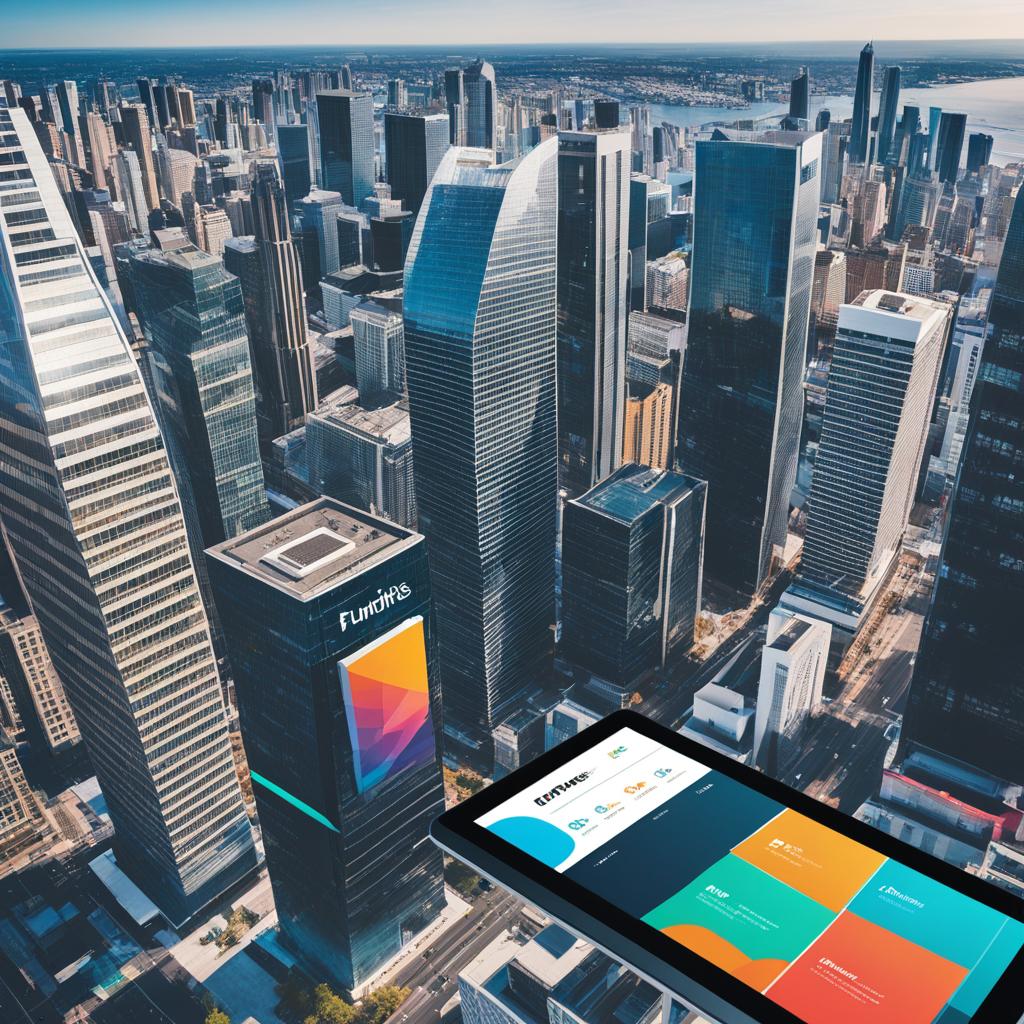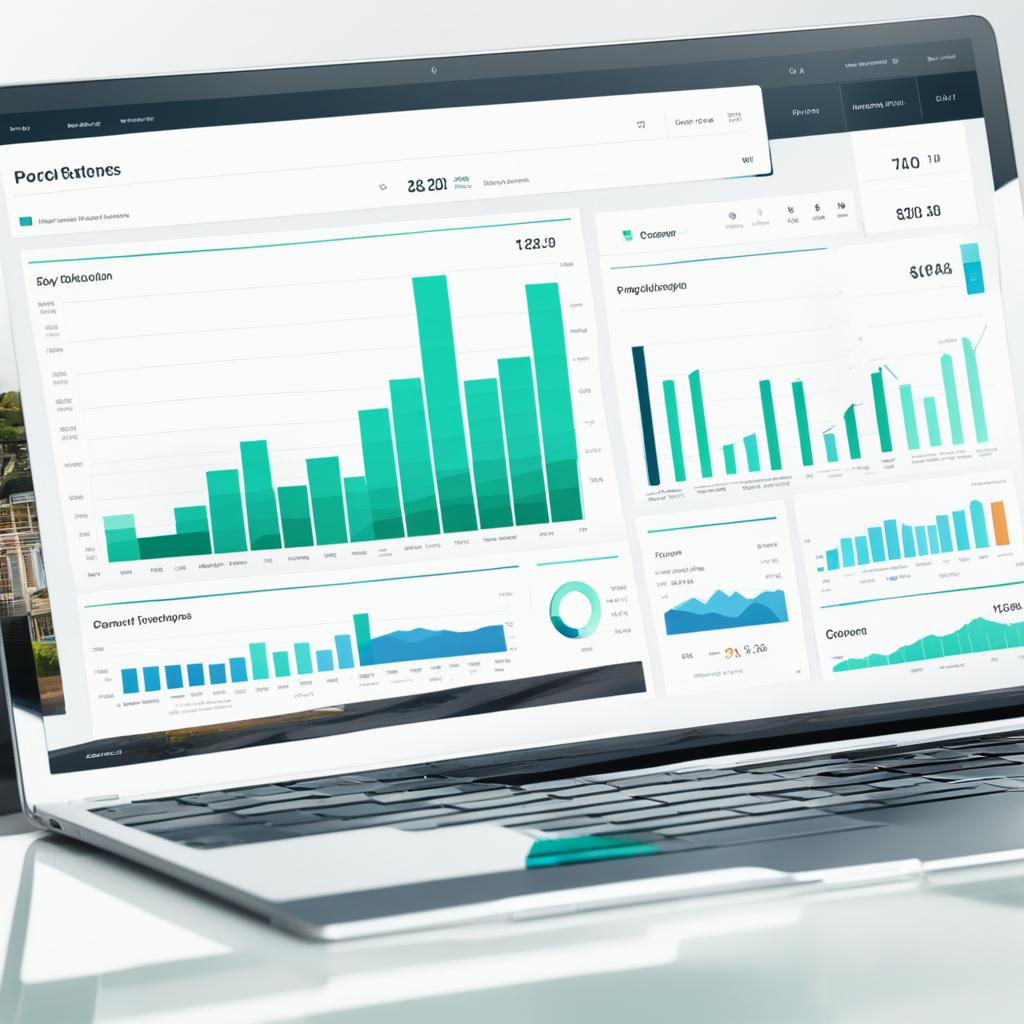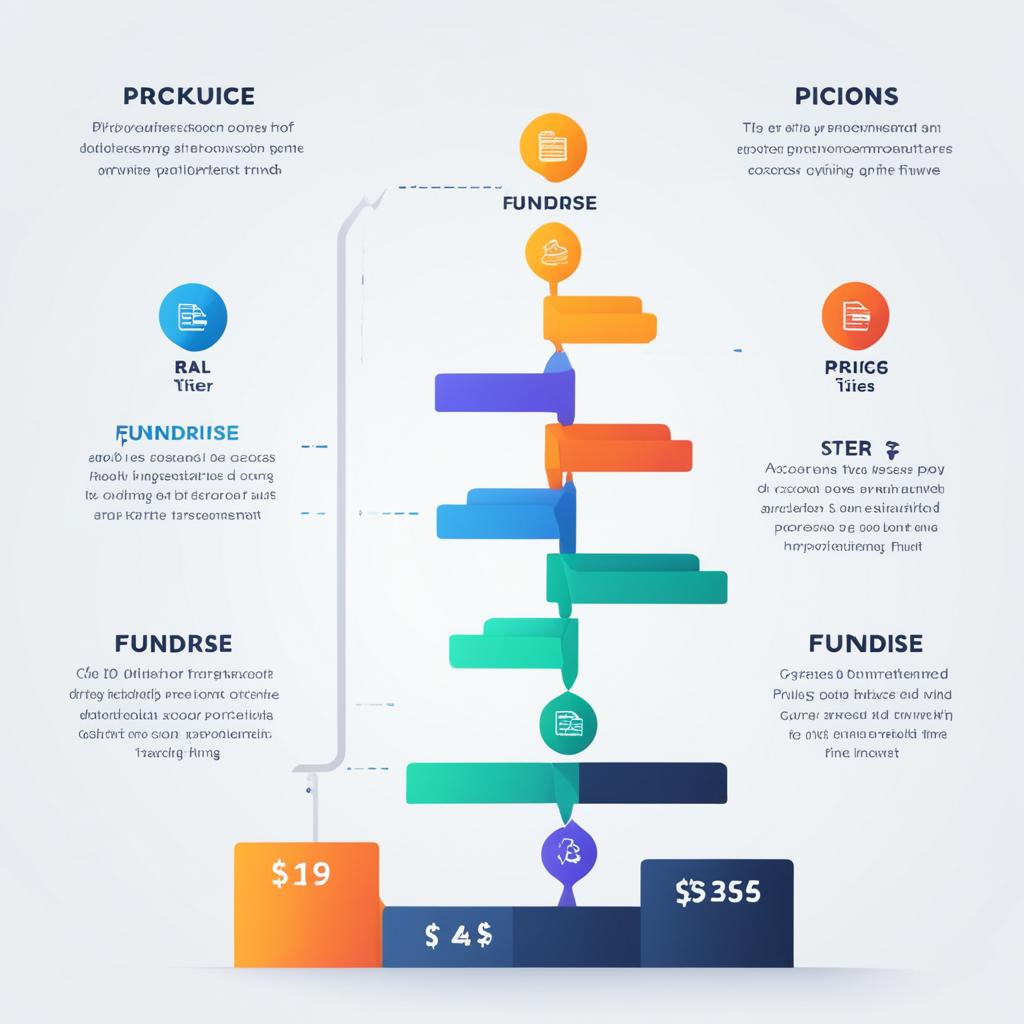Are you considering investing in real estate but don’t have the capital or expertise to do it on your own? Real estate crowdfunding platforms like Groundfloor and Fundrise offer opportunities for individuals to invest in crowdfunded real estate projects. These online investment platforms allow you to pool your money with other investors and gain access to a wide range of real estate opportunities.
In this article, I will closely examine both Groundfloor and Fundrise, comparing their offerings to help you determine which platform is best suited for your real estate investment goals. Additionally, I will introduce you to another real estate investing platform, Concreit, to provide you with even more investment options to consider.
Key Takeaways:
- Groundfloor and Fundrise are real estate crowdfunding platforms that allow investors to pool their money and invest in real estate projects.
- Groundfloor specializes in residential fix-and-flip projects and hard money loans, while Fundrise focuses on low-cost, diverse portfolios of institutional quality real estate.
- Investors can choose between debt and equity investments on both platforms, with each option carrying its own risks and potential returns.
- Concreit offers an alternative to Groundfloor and Fundrise with its liquidity options and low minimum investment requirements.
- When choosing a real estate crowdfunding platform, consider factors such as fees, repayment terms, and your own risk tolerance and investment goals.
Groundfloor Overview
Groundfloor is a real estate platform that provides investment opportunities in fix-and-flip residential projects and hard money loans. As an investor on Groundfloor, you have the opportunity to participate in the renovation and sale of residential properties. Whether you’re looking to invest or borrow money for your own project, Groundfloor offers a range of opportunities to suit your needs.
With Groundfloor, you can choose to invest in individual fix-and-flip projects or opt for hard money loans. These projects involve the purchase and renovation of residential properties, with the aim of selling them for a profit. The platform offers a diverse range of investment options, allowing you to choose projects that align with your investment goals.
One of the key features of Groundfloor is its fixed interest rate on loans. When you invest in a property loan, you receive a fixed interest rate, ensuring a predictable return on your investment. This fixed rate provides stability and allows you to plan for your future income.
Investors on Groundfloor have the advantage of being in the first position to receive their money back when investing in property loans. This means that in the event of a loan default or foreclosure, you have priority in recovering your investment.
Why Invest in Groundfloor?
“Groundfloor provides a unique opportunity for investors to participate in the lucrative fix-and-flip market. With a focus on residential renovation projects, the platform allows investors to diversify their portfolio and potentially earn attractive returns.”
| Groundfloor Features | Benefits |
|---|---|
| Fix-and-Flip Residential Projects | Diversify your investment portfolio by participating in the renovation and sale of residential properties. |
| Hard Money Loans | Invest in loans used for the purchase and renovation of properties, with the aim of generating returns. |
| Fixed Interest Rate | Enjoy a stable and predictable return on your investment with the fixed interest rate offered by Groundfloor. |
| First Position Investments | As an investor, you have priority in recovering your investment in the event of a loan default or foreclosure. |
How Does Groundfloor Work?
Groundfloor is a unique real estate lending platform that connects lenders and borrowers in a streamlined process. Let’s take a closer look at how Groundfloor works and how you can participate in this innovative investment opportunity.
Groundfloor provides funding for borrowers who are typically investors looking to renovate and flip residential properties. The loan application process is straightforward, with borrowers submitting their project details and financial information. Once a loan is approved, the borrower receives pre-funding to kickstart their project.
To make this investment opportunity accessible to a wider audience, Groundfloor converts these loans into SEC-approved securities. This means that anyone can invest in these loans, starting with a minimum investment of just $10. This low barrier to entry opens up real estate investing to a broader range of individuals and allows for greater diversification in investment portfolios.
Once you’ve invested, you’ll start earning interest payments on a monthly basis. These consistent interest payments provide you with a regular stream of passive income. At the end of the loan term, the borrower makes a final balloon payment, returning the principal amount to investors.
It’s important to note that while Groundfloor strives to work with borrowers who may face challenges in repaying their loans, there is always a risk of loan default. In such cases, Groundfloor initiates the foreclosure process to recover the investors’ funds. However, if the property is sold for an amount higher than the loan balance, investors will receive their principal amount along with the interest earned.
Groundfloor not only provides an innovative investment opportunity but also ensures that the lending process is transparent and secured. By leveraging technology and a user-friendly platform, Groundfloor offers lenders a unique chance to participate in the real estate market.
So, whether you’re a seasoned investor or just starting on your investment journey, Groundfloor presents a compelling opportunity to diversify your portfolio and earn passive income through high-quality real estate loans.
Pricing and Features of Groundfloor
When it comes to investing in real estate through Groundfloor, there are several key pricing and features to consider. Let’s take a closer look at what Groundfloor has to offer:
Investor Fees
One of the standout features of Groundfloor is that it does not charge any fees for investors. This means that you can invest in real estate projects without worrying about additional costs cutting into your returns. Groundfloor’s commitment to fee-free investing sets it apart from many other platforms in the industry.
Borrower Fees
On the borrower side, Groundfloor does charge fees. These fees include a percentage of the loan amount (ranging from 2% to 4.5%), a $250 application fee, and $1,250 in loan closing costs. These fees help to cover the costs of evaluating and processing borrower applications, ensuring that only high-quality projects make it onto the platform.
Minimum Investment
Groundfloor is committed to making real estate investing accessible to everyone. That’s why they have set the minimum investment at just $10. This low barrier to entry means that even investors with limited funds can get started and take advantage of Groundfloor’s investment opportunities.
Debt Investments
Groundfloor specializes in offering debt investments, specifically in residential fix-and-flips and hard money loans. This means that you have the opportunity to invest in projects where borrowers are looking to renovate properties and sell them for a profit. By investing in debt, you can earn interest on your investment while benefiting from the security of being in the first position to get your money back if there is a default.
Loan Terms and Risk Rating
Groundfloor’s investment terms generally average less than 12 months. This means that you have the potential to earn returns on your investment within a relatively short period of time. Additionally, Groundfloor rates the riskiness of its loans on a scale from A to G, allowing you to make informed investment decisions based on your risk tolerance and financial goals.
Actual Returns
Groundfloor has a track record of delivering solid returns to investors. To date, the actual returns on Groundfloor investments average 10.5%. These returns are a testament to the platform’s ability to identify and offer attractive investment opportunities that deliver favorable outcomes for investors.

Now that we’ve explored the pricing and features of Groundfloor, let’s move on to comparing it with another popular real estate platform, Fundrise.
Pros and Cons of Groundfloor
Groundfloor offers several advantages for investors looking to participate in real estate crowdfunding. Here are the pros of investing with Groundfloor:
- Accessible to Non-Accredited Investors: Groundfloor allows non-accredited investors to start investing in real estate with a minimum investment of just $10. This opens up the opportunity for more individuals to participate in the real estate market.
- No Fees: Investing in Groundfloor projects does not entail any fees for investors. This means that investors can allocate their entire investment amount without having to worry about deductions or additional costs.
- Debt Investments: Groundfloor provides investors with the opportunity to invest in debt, rather than equity. This allows investors to participate in loans for residential renovation and rehab loans, which often come with fixed interest rates and potentially higher returns than equity investments.
- Diversification: Groundfloor offers a variety of projects with different risk levels, allowing investors to diversify their portfolio and spread their investment across multiple properties and loan types.
- Monthly Interest Payments: Investors on Groundfloor receive monthly interest payments on their investments, providing a consistent cash flow and the potential for regular returns.
However, Groundfloor also has a few drawbacks that investors should consider:
- Higher Risk of Default: Groundfloor primarily focuses on debt investments for residential renovation and rehab loans, which can carry a higher risk of default compared to other types of real estate debt investments. It’s important for investors to carefully assess the risk associated with each investment opportunity.
- Potential Property Value Decline: Some loans on Groundfloor have high loan-to-value ratios, which means that there is a risk of incurring losses if the property value declines or if the after-repair value is overestimated.
- Foreclosure Process: In the event of a loan default, Groundfloor initiates the foreclosure process to recover the investment. However, if the property is located in a judicial-only state and the borrower files for bankruptcy, the foreclosure process can be lengthy, ultimately impacting the investor’s ability to recover their principal and interest.
Overall, Groundfloor offers accessible real estate investment opportunities for non-accredited investors with no fees and the potential for monthly interest payments. However, investors should carefully consider the risks associated with debt investments and the potential for default or property value decline.
Fundrise Overview
Fundrise is a real estate platform that offers investors the opportunity to invest in a low-cost and diverse portfolio of institutional quality real estate. By leveraging cutting-edge technology and the expertise of experienced professionals, Fundrise aims to reduce fees and maximize return potential.
With Fundrise, investors can access real estate investments that were once only available to institutional investors. The platform allows individuals to diversify their portfolios by investing in a wide range of real estate projects, including residential, commercial, and mixed-use properties.
One of the key advantages of Fundrise is its low-cost structure. By cutting out intermediaries and working directly with property owners, Fundrise eliminates unnecessary fees and ensures that investors receive the maximum return on their investments.
Furthermore, Fundrise focuses on sourcing institutional quality real estate assets, providing investors with access to high-quality properties that have been thoroughly vetted by industry professionals. This helps to mitigate risks and improve the overall quality of the investment portfolio.
Through the use of technology, Fundrise streamlines the investment process, making it easy for individuals to invest in real estate without the need for extensive knowledge or experience. The platform offers a user-friendly interface and provides investors with detailed information and insights to help them make informed investment decisions.
Overall, Fundrise offers investors a unique opportunity to participate in the real estate market and benefit from the potential returns it offers. With its low-cost structure, diverse portfolio, commitment to institutional quality real estate, and utilization of technology and experienced professionals, Fundrise is a compelling choice for individuals looking to diversify their investment portfolios and tap into the potential of the real estate market.

| Key Features of Fundrise | Benefits |
|---|---|
| Low-Cost Structure | Investors can minimize fees and maximize returns |
| Diverse Portfolio | Access to a wide range of institutional quality real estate assets |
| Institutional Quality Real Estate | Investors can tap into high-quality properties vetted by industry professionals |
| Technology-driven Platform | User-friendly interface and access to detailed investment information |
How Does Fundrise Work?
Fundrise utilizes advanced software to streamline and optimize the various processes involved in real estate investing, ultimately reducing costs and increasing efficiency. The platform operates on a value investing strategy, focusing on acquiring assets that are believed to be undervalued in the market. Fundrise takes a hands-on approach to management, actively working to enhance the value of its acquired properties over time.
Through strategic partnerships and collaborations, Fundrise curates a diverse range of investment portfolios to cater to different investor preferences and risk appetites. These portfolios include electronic real estate investment trusts (eREITs) and electronic real estate funds (eFunds), allowing investors to tailor their investment strategy according to their individual goals.
The funds raised through the platform are utilized to purchase, develop, operate, and eventually sell real estate properties, creating diversified investment opportunities for participants while aiming for long-term capital appreciation.

By leveraging technology, following a value-driven approach, and actively managing their investments, Fundrise provides investors with access to the potential returns of real estate investing without the traditional barriers to entry.
Pricing and Features of Fundrise
When considering investing in real estate through Fundrise, it’s important to understand the pricing and features offered by the platform. Fundrise provides different investment tiers to accommodate investors with varying budgets and goals. Let’s take a closer look at the options available:
- Starter: This tier requires a minimum investment of just $10, making it accessible to investors of all levels.
- Basic: The Basic tier has a minimum investment requirement of $1,000, offering investors the opportunity to increase their portfolio size.
- Core: Investors looking to make a more substantial investment can choose the Core tier, which requires a minimum investment of $5,000.
- Advanced: With a minimum investment of $10,000, the Advanced tier is designed for experienced investors looking for greater exposure.
- Premium: The Premium tier is tailored for high-net-worth individuals, with a minimum investment requirement of $100,000.
Fundrise is open to both accredited and non-accredited investors, making it accessible to a wide range of individuals. The investment lengths on the platform generally average around 5 years, allowing investors to commit their capital for a relatively moderate timeframe.
When it comes to potential returns, Fundrise has provided annualized returns of 4% to 12% depending on the investor’s chosen strategy, goals, and risk appetite. It’s important to note that past performance is not a guarantee of future results. As with any investment, there are risks involved, and returns can fluctuate.
As for fees, Fundrise charges an annual management fee of up to 1% of assets under management. This fee covers the cost of managing and operating the platform, as well as ongoing support and maintenance of investment portfolios.
To give you a clearer picture, here is a summarized table of the pricing and features of Fundrise:
| Tier | Minimum Investment | Investment Lengths | Annual Returns | Management Fee |
|---|---|---|---|---|
| Starter | $10 | Approximately 5 years | 4% – 12% | Up to 1% of assets under management |
| Basic | $1,000 | Approximately 5 years | 4% – 12% | Up to 1% of assets under management |
| Core | $5,000 | Approximately 5 years | 4% – 12% | Up to 1% of assets under management |
| Advanced | $10,000 | Approximately 5 years | 4% – 12% | Up to 1% of assets under management |
| Premium | $100,000 | Approximately 5 years | 4% – 12% | Up to 1% of assets under management |
Investing in real estate through Fundrise offers investors the opportunity to diversify their portfolio and potentially earn attractive returns. However, it’s crucial to carefully consider your financial goals, risk tolerance, and investment preferences before making a decision.

Pros and Cons of Fundrise
Fundrise offers a range of benefits for investors, but it’s important to consider both the pros and cons before making a decision.
Pros of Fundrise
- Open to Non-Accredited Investors: Fundrise allows anyone to invest, regardless of their accreditation status.
- Low Investment Minimums: With a minimum investment of just $10, Fundrise makes real estate investing accessible to a wide range of individuals.
- Potential for High Returns: Depending on your chosen investment strategy, Fundrise offers the potential for attractive returns in the real estate market.
- Redemption Program: Fundrise provides a redemption program that allows investors to sell their shares back early, although a fee is charged for this service.
Cons of Fundrise
- Risk of Underperformance: As with any investment, there is a risk that the projects in Fundrise’s portfolio may not perform as projected, resulting in lower returns than anticipated.
- Lack of Liquidity: Investments in Fundrise are typically illiquid, meaning that it may be difficult to access your funds before the investment period is completed.
- Fee for Early Redemption: If you decide to redeem your shares before the investment period is over, Fundrise charges a 1% fee, which reduces your overall returns.
It’s essential to carefully consider these pros and cons to determine if Fundrise aligns with your investment goals and risk tolerance. Keep in mind that real estate investment carries inherent risks, and it’s always wise to conduct thorough research and consult with a financial advisor before making any investment decisions.
Groundfloor vs. Fundrise: Which Is Right for You?
When deciding between Groundfloor and Fundrise as real estate crowdfunding platforms, it’s essential to consider several factors to determine which one aligns best with your investment goals and preferences. Two critical aspects to compare are fees and repayment terms, as well as the level of risk associated with each platform.
Fees
Groundfloor stands out as a more affordable option for investors, as it does not charge any fees. This makes it an attractive choice for those looking to minimize costs and maximize potential returns. On the other hand, Fundrise does charge an annual fee, which can impact overall investment performance. Consider the importance of fees in your decision-making process and how they may affect your investment outcomes.
Repayment Terms
The repayment terms of the investments on Groundfloor and Fundrise also differ. Groundfloor’s loans are typically repaid within 12 months or less. This shorter timeframe can offer faster liquidity and potential reinvestment opportunities. In contrast, Fundrise investments have a longer repayment period, which can range from several years. Consider your investment horizon and liquidity needs when evaluating the repayment terms of each platform.
Risk
Risk is another crucial factor that needs careful consideration. Groundfloor loans may carry a higher risk of default compared to Fundrise investments. Understanding the risk associated with real estate projects and loan types is essential for making informed investment decisions. Evaluate your risk tolerance and do thorough research on the risk profiles of loans offered by both platforms.
Ultimately, the choice between Groundfloor and Fundrise depends on your specific investment preferences, financial goals, and risk tolerance. Consider the factors discussed above and conduct thorough research to make an informed decision that aligns with your investment strategy.
How Does Concreit Compare to Groundfloor and Fundrise?
Concreit is another real estate investing platform that offers a unique alternative to Groundfloor and Fundrise. When comparing these platforms, several key factors come into play, such as liquidity, minimum investment, and the ability to cash out.
One significant advantage of Concreit is its liquidity. Unlike Fundrise, which charges a 1% fee for early redemption, and Groundfloor, which has a two-day window for canceling investments, Concreit allows investors to cash out their investment at any time without a minimum holding period. This flexibility gives investors more control over their investments and the ability to access their funds when needed.
Furthermore, Concreit offers a low minimum investment, making it more accessible to a wider range of investors. With Concreit, you can start investing in real estate with as little as $1.
In terms of diversification, Concreit allows investors to diversify across multiple properties. This can help mitigate risk and potentially increase returns by spreading investments across different real estate assets.
Let’s compare these features in a table:
| Concreit | Groundfloor | Fundrise | |
|---|---|---|---|
| Liquidity | High liquidity; cash out anytime with no minimum holding period | No fees for cancellation within a two-day window | 1% fee for early redemption |
| Minimum Investment | Low minimum investment starting from $1 | $10 minimum investment | Minimum investment requirements vary based on investment tiers |
| Diversification | Ability to diversify across multiple properties | Investing in individual projects | Investing in a diversified portfolio of real estate |
As you can see, Concreit offers high liquidity, a low minimum investment, and the ability to diversify across multiple properties. These features make it a compelling alternative for investors looking for more control and flexibility in their real estate investments.
Conclusion
In conclusion, Groundfloor and Fundrise are both reputable real estate crowdfunding platforms with their own advantages and disadvantages. Groundfloor specializes in residential renovation and rehab loans, while Fundrise focuses on diversified commercial real estate investments. Concreit offers a unique alternative with its liquidity and low minimum investment. When deciding between these platforms, it’s important to consider your investment goals, risk tolerance, and preferred investment options.
| Platforms | Advantages | Disadvantages |
|---|---|---|
| Groundfloor |
|
|
| Fundrise |
|
|
| Concreit |
|
|
Consider your investment goals, risk tolerance, and preferred investment options when choosing between Groundfloor, Fundrise, and Concreit. Each platform has its own strengths and weaknesses, so it’s important to conduct thorough research and seek professional advice if needed. Real estate crowdfunding offers unique investment opportunities, and these platforms provide different approaches to accessing the real estate market. Choose the platform that aligns with your investment objectives and risk profile to make the most informed decision.
Real Estate Crowdfunding Alternatives
While Groundfloor and Fundrise are popular real estate crowdfunding platforms, there are other alternatives available. Investors can explore options such as real estate investment trusts (REITs) or private real estate funds. These alternatives offer different investment structures and may have varying minimum investment requirements.
Real Estate Investment Trusts (REITs)
REITs are investment vehicles that pool money from multiple investors to invest in income-generating real estate assets, such as apartment buildings, office spaces, or shopping centers. By investing in REITs, individuals can gain exposure to the real estate market without directly owning and managing properties themselves. REITs offer the potential for regular income through dividends and the potential for capital appreciation.
Private Real Estate Funds
Private real estate funds are investment vehicles managed by professional investment firms that focus on real estate. These funds pool capital from accredited investors to invest in various real estate projects, such as commercial developments or residential properties. Private real estate funds often have specific investment strategies and may target specific types of properties or regions. These funds offer the potential for attractive returns through active management and strategic investments.
Investors considering real estate crowdfunding alternatives should carefully evaluate the investment structures, risk profiles, and potential returns of REITs and private real estate funds. It is also essential to consider factors such as investment minimums, liquidity, and the expertise of the fund managers.
With various alternatives to choose from, investors can diversify their real estate investment portfolios and find the option that best aligns with their financial goals and risk tolerance.
| Real Estate Crowdfunding Alternatives | Investment Structures | Risk Profile | Potential Returns | Minimum Investment |
|---|---|---|---|---|
| Real Estate Investment Trusts (REITs) | Invests in income-generating real estate assets | Varies depending on the type of REIT | Dividends and potential capital appreciation | Varies depending on the REIT |
| Private Real Estate Funds | Invests in various real estate projects | Varies depending on the fund’s strategy | Potential for attractive returns through active management | Varies depending on the fund |
How Do I Choose the Best Real Estate Crowdfunding Platform for Me?
When it comes to selecting the ideal real estate crowdfunding platform for your investment needs, several factors should be taken into consideration. Firstly, think about your investment goals. Are you looking for short-term gains through fix-and-flip residential projects, or are you focusing on long-term investments in institutional quality real estate?
Another important factor is your risk tolerance. Real estate investments, although potentially lucrative, do come with risks. Assess how comfortable you are with potential fluctuations in property values and the possibility of loan defaults before making a decision.
Liquidity is also crucial. Determine whether you prefer a platform that allows for easy withdrawal of your investment or if you are willing to commit your funds for a longer period of time. Additionally, be mindful of the fees associated with each platform. Consider the costs you’ll incur, including management fees or loan fees, and evaluate how they align with your investment strategy.
By carefully evaluating these factors and comparing different real estate crowdfunding platforms, you can make an informed decision that aligns with your financial goals and preferences. Remember to diversify your investments to spread out risks. If you’re uncertain about any aspect of real estate crowdfunding, don’t hesitate to seek guidance from a professional advisor.
FAQ
What is Groundfloor?
Groundfloor is a real estate platform where investors can find fix-and-flip residential projects and hard money loans to invest in.
How does Groundfloor work?
Groundfloor lends money to borrowers and sells pieces of those loans to investors. Borrowers use the funds to renovate houses and sell them. Investors can choose to invest in individual projects or use Groundfloor’s analysis tools to find projects that meet their criteria.
What are the fees for Groundfloor?
Groundfloor does not charge any fees for investors. Borrowers, on the other hand, pay fees that include 2%-4.5% of the loan amount, a 0 application fee, and
FAQ
What is Groundfloor?
Groundfloor is a real estate platform where investors can find fix-and-flip residential projects and hard money loans to invest in.
How does Groundfloor work?
Groundfloor lends money to borrowers and sells pieces of those loans to investors. Borrowers use the funds to renovate houses and sell them. Investors can choose to invest in individual projects or use Groundfloor’s analysis tools to find projects that meet their criteria.
What are the fees for Groundfloor?
Groundfloor does not charge any fees for investors. Borrowers, on the other hand, pay fees that include 2%-4.5% of the loan amount, a $250 application fee, and $1,250 in loan closing costs.
What are the pros of investing in Groundfloor?
Pros of investing in Groundfloor include the ability for anyone to invest with a minimum investment of $10, no fees to invest, the opportunity to invest in debt instead of equity, diversification across different risk levels, and monthly interest payments.
What are the cons of investing in Groundfloor?
Cons of investing in Groundfloor include the focus on debt investments for residential renovation and rehab loans, which may have a higher risk of default compared to other types of real estate debt investments. Some loans on Groundfloor have high loan-to-value ratios, which can result in losses if the property value declines or the after-repair value is overestimated. Additionally, loans made on properties in judicial-only states can take a long time to foreclose if the borrower files for bankruptcy.
What is Fundrise?
Fundrise is a real estate platform that allows investors to invest in a low-cost, diverse portfolio of institutional quality real estate. The platform utilizes cutting-edge technology and experienced professionals to reduce fees and maximize return potential.
How does Fundrise work?
Fundrise acquires undervalued assets and works to increase their value over time. The platform offers various portfolios, including eREITs and eFunds, allowing investors to choose their investment strategy. The funds are used to purchase, develop, operate, and eventually sell real estate properties.
What are the fees for Fundrise?
Fundrise charges an annual management fee of up to 1% of assets under management.
What are the pros of investing in Fundrise?
Pros of investing in Fundrise include the ability for anyone to invest, low investment minimums starting from $10, the potential for high returns based on the chosen investment strategy, and a redemption program that allows investors to sell their shares back early for a fee.
What are the cons of investing in Fundrise?
Cons of investing in Fundrise include the risk of making less than anticipated if the projects don’t perform as projected, the lack of liquidity in the investments, and the 1% fee for early redemption of funds.
How does Concreit compare to Groundfloor and Fundrise?
Concreit offers liquidity, allowing investors to cash out their investment at any time with no minimum holding period. In contrast, Fundrise has a 1% fee for early redemption, and Groundfloor has a two-day window for canceling investments. Concreit also offers a low minimum investment and the ability to diversify across multiple properties.
What are some real estate crowdfunding alternatives to Groundfloor and Fundrise?
Some alternatives include real estate investment trusts (REITs) or private real estate funds, each offering different investment structures and varying minimum investment requirements.
How do I choose the best real estate crowdfunding platform for me?
To choose the best real estate crowdfunding platform, consider factors such as your investment goals, risk tolerance, desired liquidity, and fees. Evaluate the different platforms based on these criteria to find the one that aligns with your financial goals and preferences.
,250 in loan closing costs.
What are the pros of investing in Groundfloor?
Pros of investing in Groundfloor include the ability for anyone to invest with a minimum investment of , no fees to invest, the opportunity to invest in debt instead of equity, diversification across different risk levels, and monthly interest payments.
What are the cons of investing in Groundfloor?
Cons of investing in Groundfloor include the focus on debt investments for residential renovation and rehab loans, which may have a higher risk of default compared to other types of real estate debt investments. Some loans on Groundfloor have high loan-to-value ratios, which can result in losses if the property value declines or the after-repair value is overestimated. Additionally, loans made on properties in judicial-only states can take a long time to foreclose if the borrower files for bankruptcy.
What is Fundrise?
Fundrise is a real estate platform that allows investors to invest in a low-cost, diverse portfolio of institutional quality real estate. The platform utilizes cutting-edge technology and experienced professionals to reduce fees and maximize return potential.
How does Fundrise work?
Fundrise acquires undervalued assets and works to increase their value over time. The platform offers various portfolios, including eREITs and eFunds, allowing investors to choose their investment strategy. The funds are used to purchase, develop, operate, and eventually sell real estate properties.
What are the fees for Fundrise?
Fundrise charges an annual management fee of up to 1% of assets under management.
What are the pros of investing in Fundrise?
Pros of investing in Fundrise include the ability for anyone to invest, low investment minimums starting from , the potential for high returns based on the chosen investment strategy, and a redemption program that allows investors to sell their shares back early for a fee.
What are the cons of investing in Fundrise?
Cons of investing in Fundrise include the risk of making less than anticipated if the projects don’t perform as projected, the lack of liquidity in the investments, and the 1% fee for early redemption of funds.
How does Concreit compare to Groundfloor and Fundrise?
Concreit offers liquidity, allowing investors to cash out their investment at any time with no minimum holding period. In contrast, Fundrise has a 1% fee for early redemption, and Groundfloor has a two-day window for canceling investments. Concreit also offers a low minimum investment and the ability to diversify across multiple properties.
What are some real estate crowdfunding alternatives to Groundfloor and Fundrise?
Some alternatives include real estate investment trusts (REITs) or private real estate funds, each offering different investment structures and varying minimum investment requirements.
How do I choose the best real estate crowdfunding platform for me?
To choose the best real estate crowdfunding platform, consider factors such as your investment goals, risk tolerance, desired liquidity, and fees. Evaluate the different platforms based on these criteria to find the one that aligns with your financial goals and preferences.
Our Friends
- https://www.concreit.com/blog/groundfloor-vs-fundrise
- https://barbarafriedbergpersonalfinance.com/fundrise-vs-diversyfund-vs-groundfloor/
- https://millennialmoneyman.com/groundfloor-vs-fundrise/
Money posts:
 Groundfloor Review – Investing (2024)
Groundfloor Review – Investing (2024)
 Yieldstreet vs. Fundrise: Which Platform is Best? (2024)
Yieldstreet vs. Fundrise: Which Platform is Best? (2024)
 Fundrise Review (Newly Launched $10 Starter Portfolio) (2024)
Fundrise Review (Newly Launched $10 Starter Portfolio) (2024)
 CrowdStreet vs. Fundrise: Which Real Estate Platform Is Best for Your Portfolio Growth in 2024?
CrowdStreet vs. Fundrise: Which Real Estate Platform Is Best for Your Portfolio Growth in 2024?
 Best Real Estate Investing Apps (2024)
Best Real Estate Investing Apps (2024)
 13 Best Real Estate Investing Books (2024)
13 Best Real Estate Investing Books (2024)
 CrowdStreet Review: Commercial Real Estate (2024)
CrowdStreet Review: Commercial Real Estate (2024)
 14 Best Real Estate Crowdfunding Platforms (2024)
14 Best Real Estate Crowdfunding Platforms (2024)

